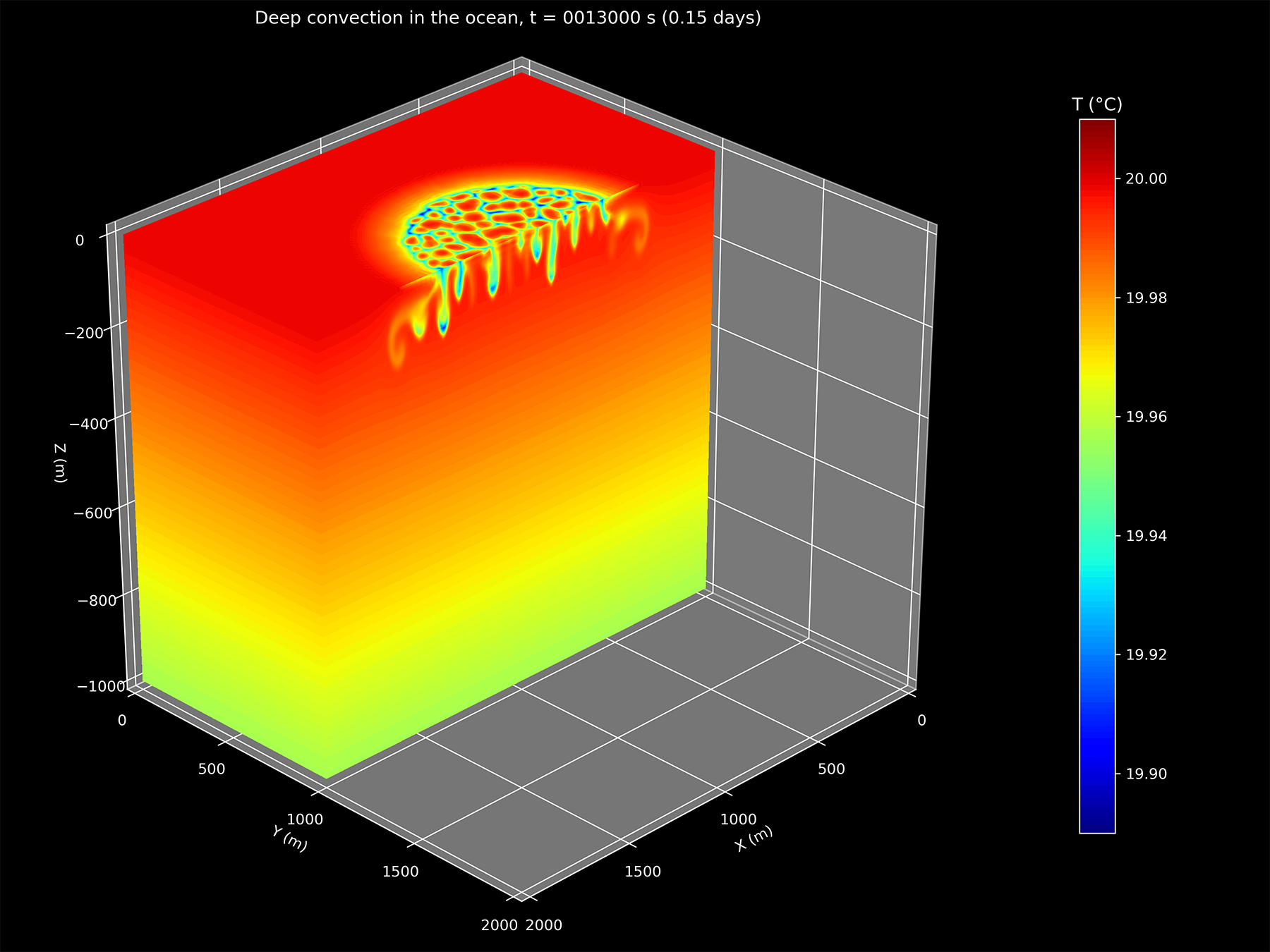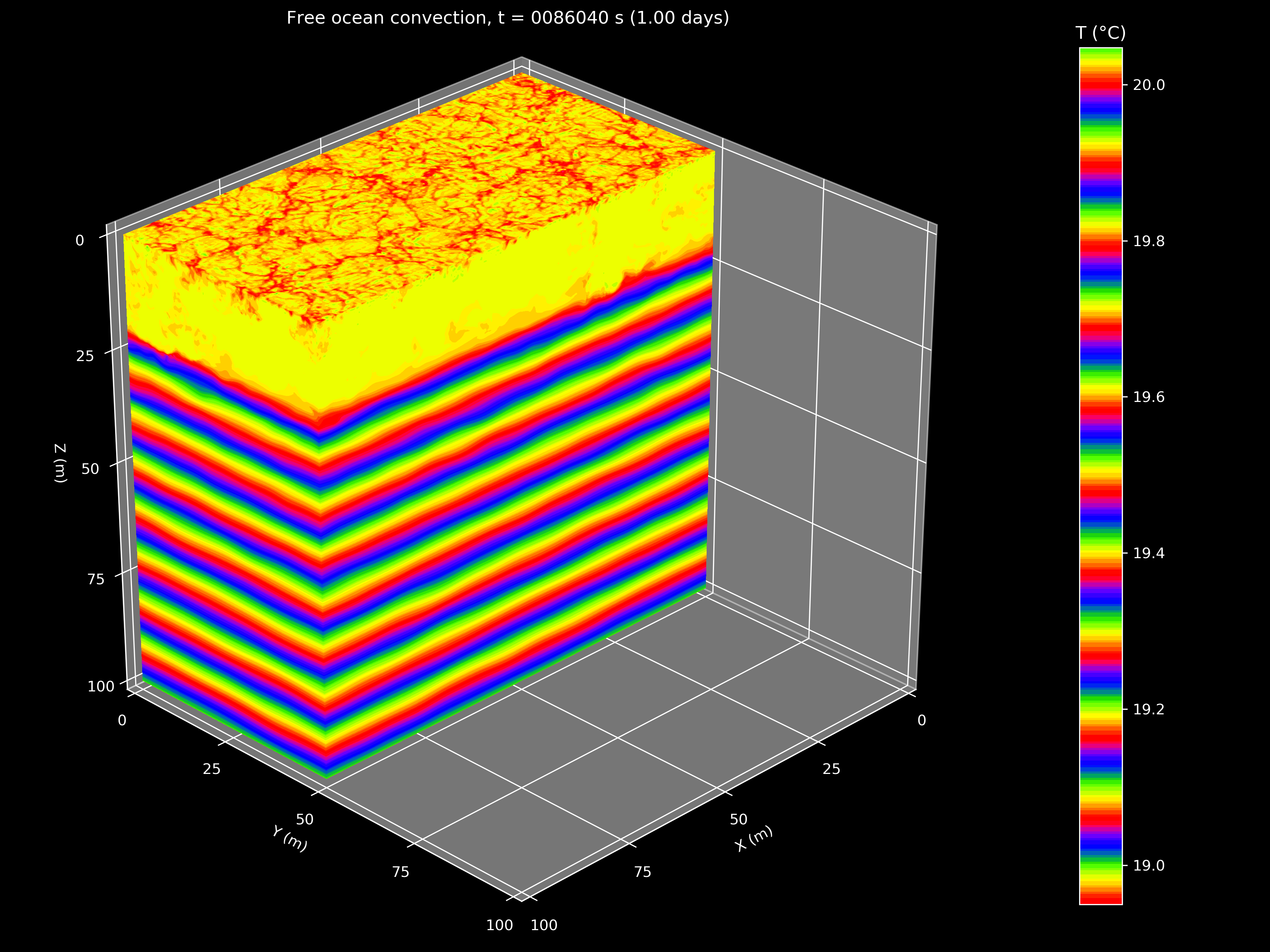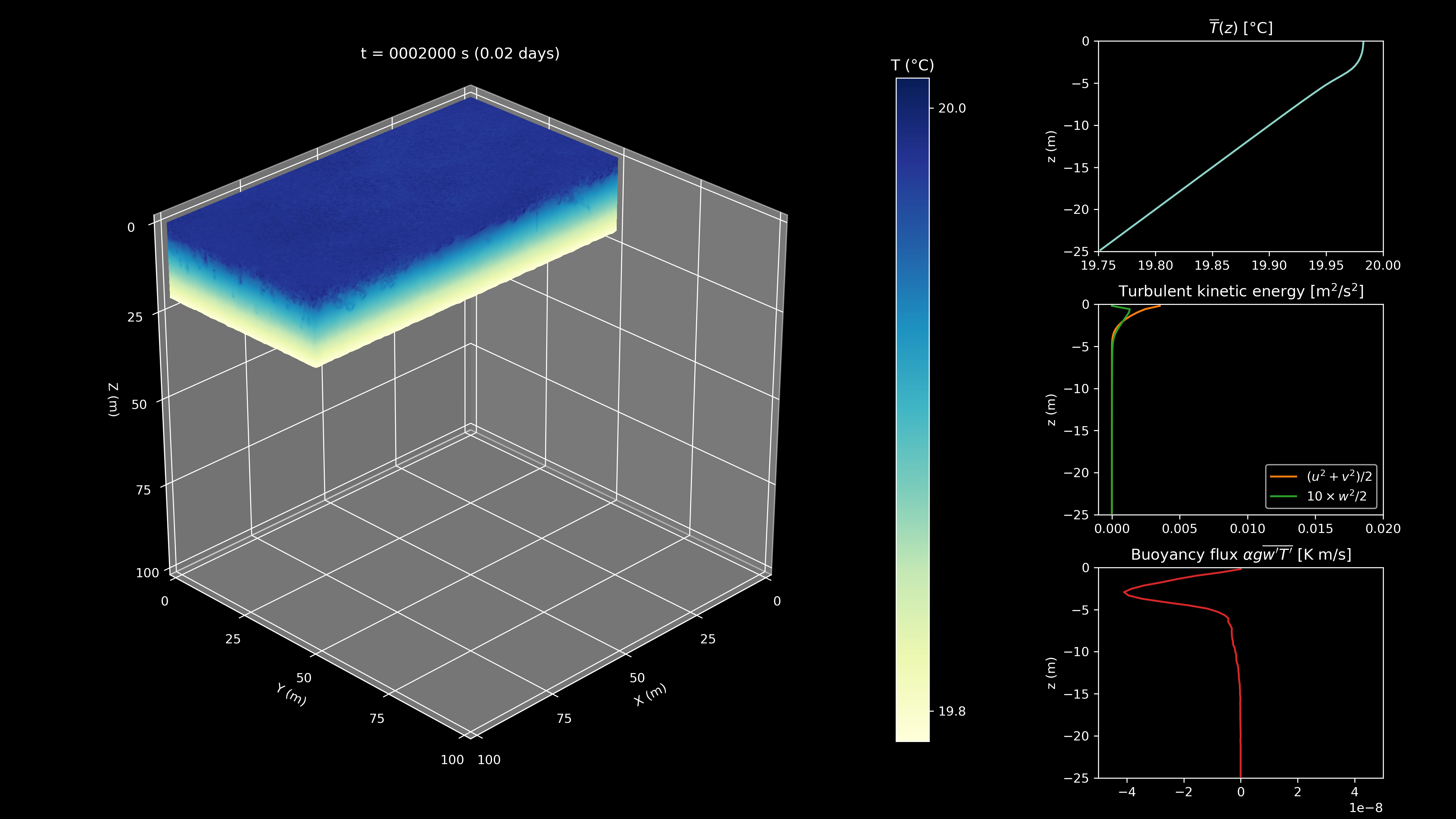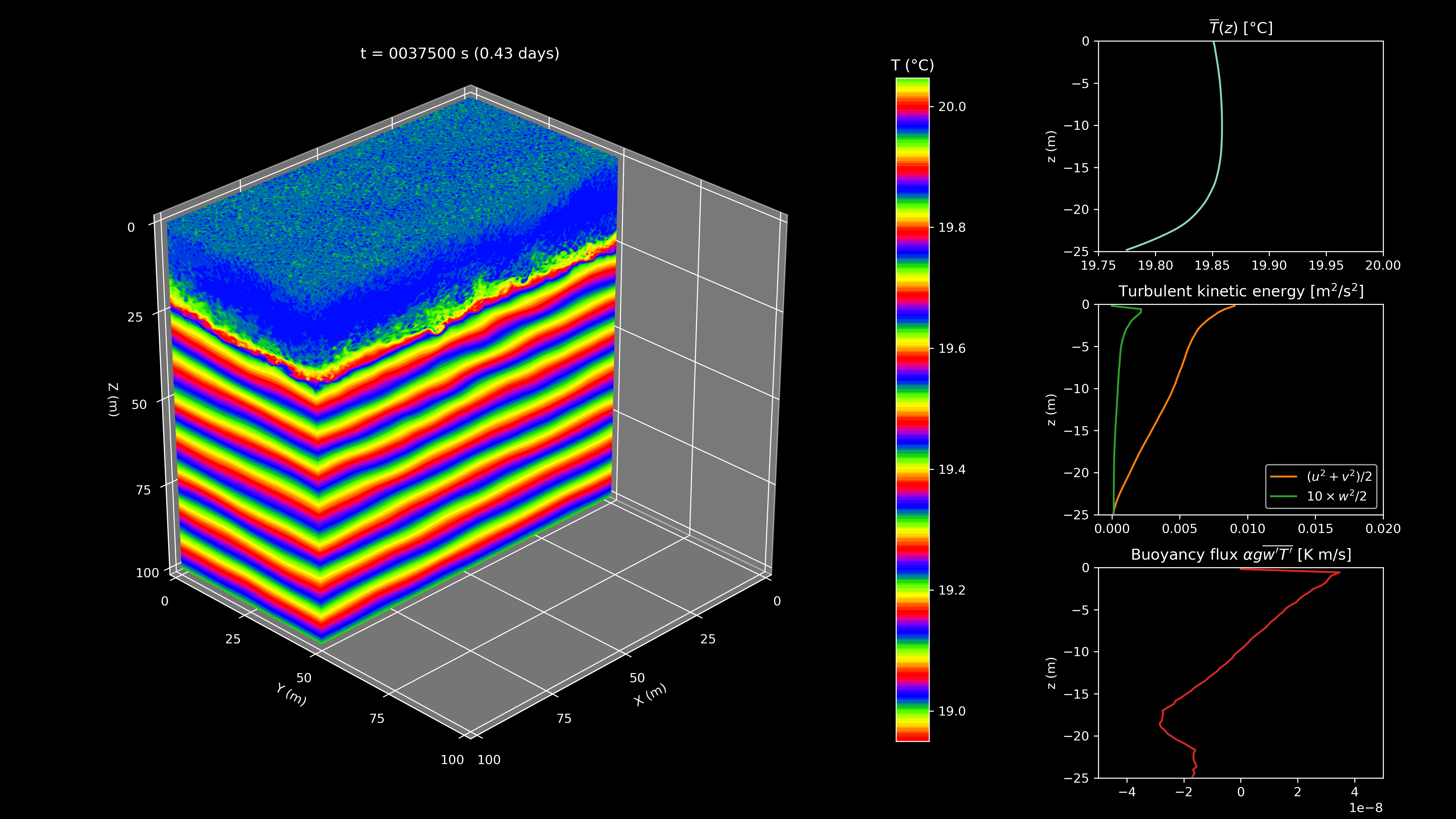Oceananigans.jl is a fast and friendly incompressible fluid flow solver written in Julia that can be run in 1-3 dimensions on CPUs and GPUs. It is designed to solve the rotating Boussinesq equations used in non-hydrostatic ocean modeling but can be used to solve for any incompressible flow.
Our goal is to develop a friendly and intuitive package allowing users to focus on the science. Thanks to high-level, zero-cost abstractions that the Julia programming language makes possible, the model can have the same look and feel no matter the dimension or grid of the underlying simulation, and the same code is shared between the CPU and GPU.
Contents
- Installation instructions
- Running your first model
- Getting help
- Movies
- Performance benchmarks
- Development team
Installation instructions
You can install the latest version of Oceananigans using the built-in package manager (accessed by pressing ] in the Julia command prompt) to add the package and instantiate/build all depdendencies
julia>]
(v1.3) pkg> add Oceananigans
(v1.3) pkg> instantiate
We recommend installing Oceananigans with the built-in Julia package manager, because this installs a stable, tagged release. Oceananigans.jl can be updated to the latest tagged release from the package manager by typing
(v1.3) pkg> update Oceananigans
At this time, updating should be done with care, as Oceananigans is under rapid development and breaking changes to the user API occur often. But if anything does happen, please open an issue!
Note: Oceananigans requires at least Julia v1.3 to run. Installing Oceananigans with an older version of Julia will install an older version of Oceananigans (the latest version compatible with your version of Julia).
Running your first model
Let's initialize a 3D horizontally periodic model with 100×100×50 grid points on a 2×2×1 km domain and simulate it for 1 hour using a constant time step of 60 seconds.
using Oceananigans
grid = RegularCartesianGrid(size=(100, 100, 50), length=(2000, 2000, 1000))
model = IncompressibleModel(grid=grid)
simulation = Simulation(model, Δt=60, stop_time=3600)
run!(simulation)
You just simulated what might have been a 3D patch of ocean, it's that easy! It was a still lifeless ocean so nothing interesting happened but now you can add interesting dynamics and visualize the output.
More interesting example
Let's add something to make the dynamics a bit more interesting. We can add a hot bubble in the middle of the domain and watch it rise to the surface. This example also shows how to set an initial condition.
using Oceananigans
N = Nx = Ny = Nz = 128 # Number of grid points in each dimension.
L = Lx = Ly = Lz = 2000 # Length of each dimension.
topology = (Periodic, Periodic, Bounded)
model = IncompressibleModel(
architecture = CPU(),
grid = RegularCartesianGrid(topology=topology, size=(N, N, N), length=(L, L, L)),
closure = ConstantIsotropicDiffusivity(ν=4e-2, κ=4e-2)
)
# Set a temperature perturbation with a Gaussian profile located at the center.
# This will create a buoyant thermal bubble that will rise with time.
x₀, z₀ = Lx/2, Lz/2
T₀(x, y, z) = 20 + 0.01 * exp(-100 * ((x - x₀)^2 + (z - z₀)^2) / (Lx^2 + Lz^2))
set!(model, T=T₀)
simulation = Simulation(model, Δt=10, stop_iteration=5000)
run!(simulation)
By changing architecture = CPU() to architecture = GPU(), the example will run on an Nvidia GPU!
GPU model output can be plotted on-the-fly and animated using Makie.jl! This NextJournal notebook has an example. Thanks @SimonDanisch! Some Makie.jl isosurfaces from a rising spherical thermal bubble (the GPU example):
You can see some movies from GPU simulations below along with CPU and GPU performance benchmarks.
Getting help
If you are interested in using Oceananigans.jl or are trying to figure out how to use it, please feel free to ask us questions and get in touch! Check out the examples and open an issue if you have any questions, comments, suggestions, etc.
Contributing
If you're interested in contributing to the development of Oceananigans we want your help no matter how big or small a contribution you make! It's always great to have new people look at the code with fresh eyes: you will see errors that other developers have missed.
Let us know by opening an issue if you'd like to work on a new feature or if you're new to open-source and want to find a cool little project or issue to work on that fits your interests! We're more than happy to help along the way.
For more information, check out our contributor's guide.
Movies
Deep convection
Free convection
Winds blowing over the ocean
Free convection with wind stress
Performance benchmarks
We've performed some preliminary performance benchmarks (see the benchmarks.jl file) by initializing models of various sizes and measuring the wall clock time taken per model iteration (or time step). The CPU used was a single core of an Intel Xeon CPU E5-2680 v4 @ 2.40GHz while the GPU used was an Nvidia Tesla V100-SXM2-16GB. This isn't really a fair comparison as we haven't parallelized across all the CPU's cores so we will revisit these benchmarks once Oceananigans.jl can run on multiple CPUs and GPUs.

Development team
- Ali Ramadhan (@ali-ramadhan)
- Greg Wagner (@glwagner)
- Chris Hill (@christophernhill)
- Jean-Michel Campin (@jm-c)
- John Marshall (@johncmarshall54)
- Andre Souza (@sandreza)
- On the Julia side, big thanks to Valentin Churavy (@vchuravy), Tim Besard (@maleadt) and Peter Ahrens (@peterahrens)!



